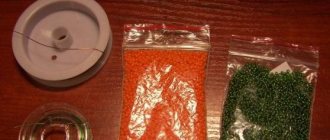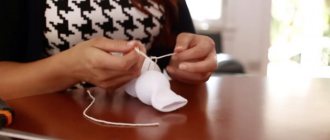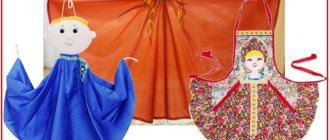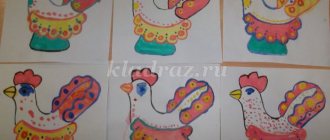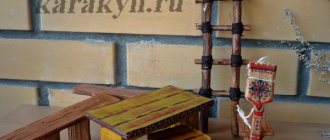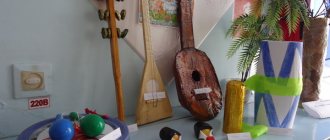Project “The History of the New Year’s Toy”
Stages of work on the project:
Stage I. Preparatory and informational:
1. Selection of educational and illustrative material about the history of New Year's toys.
2. Prepare a slide presentation about the history of New Year's toys.
3. Prepare a film “Production of Christmas tree decorations in Russia” for children to watch.
4. Reading poems, riddles about New Year’s decorations (Elena Blagina “About the Christmas tree, about the gray wolf, about the dragonfly and about the poor goat”)
5. Consultation for parents “The History of a New Year’s Toy.” Raise the information level and awareness of parents on this issue.
6. Invite parents to take part in the project “The History of New Year’s Toys” (help in organizing the exhibition “Museum of New Year’s Toys”)
The project was carried out through educational areas: social and communicative development, cognitive development, speech development, artistic and aesthetic development.
Stage II. Research and creative:
1. Joint cognitive activity “Getting to know the Christmas tree toy.” Introduce children to the history of the origin of the Christmas tree toy and the materials from which it is made.
2. Show a slide presentation about the history of New Year's toys.
3. Show a slide presentation about the history of the creation of New Year's beads.
4. Joint activities with children, exhibition “Museum of New Year's Toys”.
5. Reading poems about New Year's toys.
6. Joint activity with children on drawing “Our Christmas tree is beautiful.”
7. Joint activity with children to sculpt “Yolka toys”.
8. Joint activity with children on appliqué and manual labor “New Year’s ball”. Develop children's motor functions in the process of scientific research activities. Develop a sense of form, color and composition. Develop creative imagination, artistic taste, creative initiative. Foster independence, hard work, and accuracy.
9. Compose a descriptive story about your favorite Christmas tree toy.
10.Designing the group for the holiday.
Stage III. Final.
1. Exhibition of children's works.
2.Watching Soviet cartoons for children. Collection about the New Year.
3. Awarding medals to active parents for participation in the organization and implementation of the project.
Expected outcome of the project:
- increasing the interest of preschoolers in the history of New Year's toys;
— increasing the level of awareness of parents about forms of joint cognitive activity with children;
- active participation of parents in the life of the kindergarten and group;
— development of children’s creative abilities;
— development of motor functions in children’s research activities.
Conclusion:
Children learned the history of the origin and modification of New Year's toys, about the tradition of decorating the Christmas tree with toys. Skills have been developed in making New Year's toys in different ways using different materials; creative - aesthetic perception. Parents actively got involved in the work - they brought old New Year's toys for the exhibition - museum.
Papier mache
Museum of Christmas tree decorations “Klinskoye Compound”, Klin. Photo: S. Lavrentyev / photobank “Lori”
Museum of Christmas tree decorations “Klinskoye Compound”, Klin. Photo: S. Lavrentyev / photobank “Lori”
Museum of Christmas tree decorations “Klinskoye Compound”, Klin. Photo: S. Lavrentyev / photobank “Lori”
Jewelry made from papier-mâché (a dense substance consisting of paper pulp mixed with glue, plaster or chalk) became widespread in the Soviet Union. In the USSR, the production of papier-mâché toys was manual and consisted of a number of lengthy operations: modeling, putty, priming, sanding, painting, painting with intermediate drying at temperatures from 20 to 60°. The assortment consisted mainly of realistic figures of people and animals. The coating of burt salt made the surface of the toys more dense and gave them a dull shine. Using vacuum casting, New Year's masks and large figures for the Christmas tree (Santa Claus and Snow Maiden) were created. Such toys were light in weight, but not inferior in strength to pressed ones.
Nowadays, among numerous collectors of New Year's decorations, preserved papier-mâché toys are the most valuable.
Cartonage
Cardboard toys
Cardboard toys
Cardboard toy, 1976. Photo: A. Stepanov / photobank “Lori”
Cardboard toys began to be made as decorations at an affordable price. These embossed figures were cut and glued from two halves of raised cardboard, tinted with gold or silver paint. It was not difficult to make them, and popular models were even published in Soviet newspapers. If desired, cartons could be ordered by mail from private workshops. Among the cardboard toys, images of animals, fish, birds, fairy-tale characters and stars were popular.
LiveInternetLiveInternet
Charlie1969
all posts by the author The first Christmas trees in Russia appeared in the 19th century. They were placed on the roofs and fences of drinking establishments as decoration. They began decorating Christmas trees in 1860-1870, repeating European fashion. There were no Russian-made Christmas decorations at that time; they were ordered from Europe. Even then, Christmas tree decorations were clearly divided into decorations for the wealthy and for those who were poorer. Buying a glass toy for a resident of Russia at the end of the 19th century was the same as buying a car for a modern Russian. Christmas balls were heavy, since they learned to make thin glass only at the beginning of the 20th century.
The first glass toys in the USSR began to be made during the First World War in Klin. There, artel craftsmen blew glass products for pharmacies and other needs. But during the war years, captured Germans taught them how to blow balls and beads. The Klin factory “Yolochka”, by the way, to this day remains the only factory in Russia that makes beads for Christmas trees.
In addition to glass, toys were made from cardboard. In pre-revolutionary Russia, “Dresden cardboard” was popular - toys glued together from two halves of convex tinted cardboard.
Beautiful dolls with lithographic (paper) faces glued to a “body” made of fabric, lace, beads, and paper were also hung on Christmas trees. By the 20th century, faces began to be made convex, made of cardboard, and later - porcelain.
There were also toys made of cotton wool wound onto a wire frame: this is how figures of children, angels, clowns, and sailors were decorated. Fake fruits made of papier-mâché and velvet were hung on the Christmas trees. The star of Bethlehem, six-pointed, was fixed on the top, unlike the Soviet one. And the tradition of crowning a Christmas tree with a decoration in the shape of a lance is connected not with the shape of ice icicles, but with the design of military helmets from the times of the Kaiser’s Germany: lance-shaped tops for Christmas trees began to be made there. They were decorated with figurines of doves and bells. By the way, jewelry in the shape of icicles began to be made in the USSR only during the “Thaw”. In 1925, New Year celebrations in Russia were banned and resumed only in 1935. But the New Year was made a Soviet holiday - accordingly, New Year's toys changed. Figures of children, clowns, ballerinas, birds, animals, fruits and vegetables, of course, remained. And instead of angels, pioneers, Budenovites, Red Army soldiers, and women in red headscarves appeared. The era of aeronautics was reflected on Christmas trees with toys-airships with the inscription “USSR”, airplanes, parachutes with tiny parachutists.
Figures of tanks and Stalin's armored cars were hung on Christmas trees. In the late 30s, heroes of children's literature appeared on Christmas trees - Ivan Tsarevich, Ruslan and Lyudmila, Brother Rabbit and Brother Fox, Little Red Riding Hood, Puss in Boots, Crocodile with Totosha and Kokosha, Doctor Aibolit. With the release of the film “Circus,” circus-themed figurines became popular. The exploration of the North was marked by figures of polar explorers. Also, at the end of the 30s, a series of Christmas tree decorations on an oriental theme were released - these are Aladdin, and old Hottabych, and oriental beauties... These toys are distinguished by oriental filigree of shapes and hand-painting.
During the Patriotic War, Christmas trees at the fronts were decorated with figurines made from shoulder straps, bandages, and socks. Toys were also produced, in limited quantities, of course. Decorating the Christmas tree for the New Year was mandatory - this ritual reminded of a peaceful life and gave strength to hope for a quick victory. “Military” Christmas trees were decorated with “soldiers,” “tanks,” “pistols,” and “orderly dogs”; even Santa Claus beat the Nazis on New Year's cards... In the early 40s, New Year's toys appeared in the form of household items. They are distinguished by fluidity of form and painting with bright colors.
After the war, January 1 again became a day off (this happened in 1947). And the Christmas tree decorations became peaceful again.
In the early 1950s, when there was a shortage of food in the country, many toys were made in the form of fruits, berries and vegetables (inedible, of course). Fairy-tale characters also appeared: Aibolit, Father Frost, Snow Maiden, Chipollino, various animals: squirrels, bears, hares. At the same time, in the 50s, a fashion for glass beads and compositions from glass balls, beads and sticks appeared.
34.
In the 60s, with the advent of fashion for minimalism and avant-garde, everything was simplified as much as possible. The figures became puffy, the paintings became simpler. But at the same time, a new material appeared - foam rubber. They are beginning to actively use it in the production of Christmas tree decorations. For example, they produced nesting dolls in foam rubber scarves, tails and scallops, and pig snouts were made from foam rubber. There was a toy in the form of a large glass ball, which was transparent on one side and silver-plated on the other. The back, silver wall beautifully reflected a foam fish “swimming” inside the ball.
Plastic is beginning to be actively used in the production of toys: for example, spotlight balls and polyhedron balls, like those at discos, were produced in large quantities. There were plastic transparent balls with plastic butterflies “flying” inside them. The children broke these balls and then played with the butterflies. In the 70-80s, New Year's toys in the form of pine cones, bells and houses became popular: Since nothing significant had happened in the history of the country since Brezhnev's times, there were noticeably fewer themed toys. The toys became more and more abstract. In fact, all that Russian manufacturers can offer their consumers today is a toy “a la Russe”, with traditional paintings. Unfortunately, they are far from the variety that Europeans offer - toys made of wire and chains, all kinds of fabrics and furs, fluff and feathers, paper, beads, sequins, rhinestones and even precious metals and stones. Since the early 2000s, original, “homemade” toys have become popular. If we talk about the fashion for Christmas tree decorations, some manufacturers say that the fashion for decorations repeats itself every four years, so you can simply put old toys in a box and wait until they become relevant again.
The most important gift that every New Year gives us is hope for the best and the belief that even the impossible is possible!
